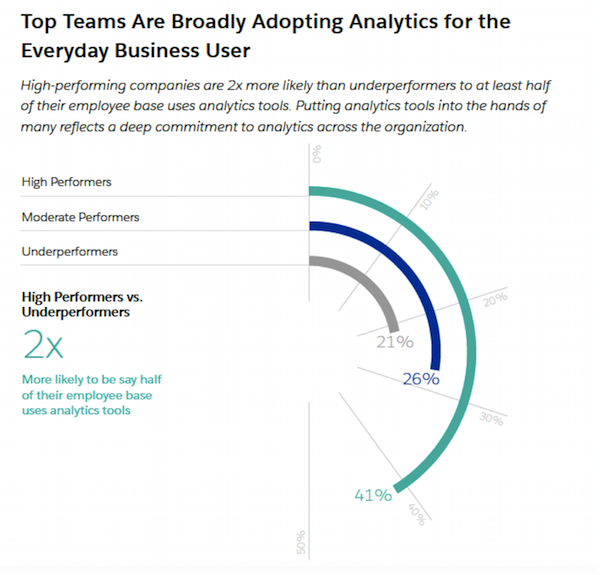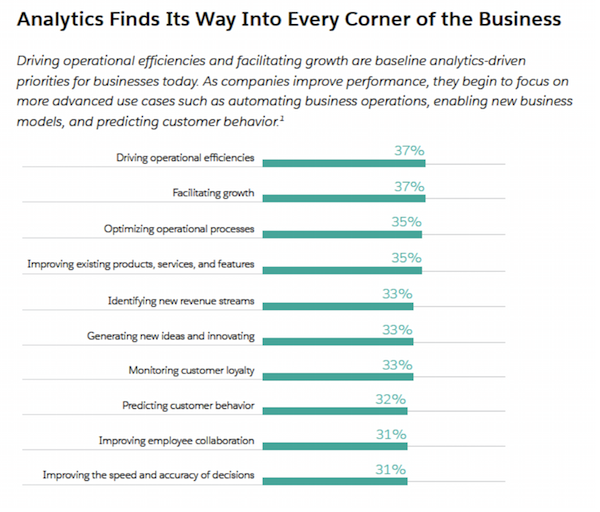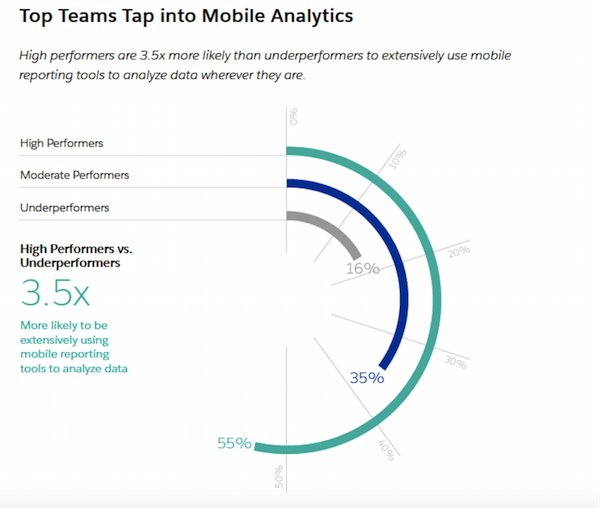
Get your FREE 30-day trial.
Please complete all fields.
After surveying over 2,000 business leaders, directors, and executives worldwide, Salesforce Research found that top performing companies in 2015 are focused on creating a culture of analytics. What is a culture of analytics? It’s the commitment, supported by executives, to place the power of data in the hands of more business users across their company, using modern analytics tools.
Ninety percent of high performing companies say analytics is absolutely critical or very important to driving the company’s business strategy and improving operational outcomes, according to the 2015 State of Analytics research. So how can you bring a culture of analytics to your company and start outperforming your competitors? Here are 5 ways:
Making sense of all the available data can seem daunting. Many business leaders struggle to find the right data and connect it to the appropriate actions. Hours are spent updating spreadsheets or waiting for answers from the IT departments. Over half of business leaders surveyed listed “manual processes behind getting all the necessary data into one view” and “too much unanalyzed data” as their top pain points when it comes to using analytics.
The solution lies in modern analytics tools, like Salesforce Wave Analytics, that pull all of your data into a single view, allow you to drill deeper into the data, gain relevant insights, and take action in real time. The 2015 study shows that high-performing companies are 6.4x more likely than underperformers to increase analytics spend by 50% or more over the next two years.
The innovation of smart analytics tools is democratizing data across organizations. Employees no longer need to consult data scientists to gather trends and insights from data. They now have analytics at their fingertips. According to the survey, high-performing companies are 2x more likely than underperformers to say half of their employee base uses analytics tools. Top companies are encouraging data-driven decision making at every level of the business.

Leading companies don’t make decisions based on their gut, they use data to drive answers. Once you can understand and dissect the data presented, you can use the numbers for more than just simple performance tracking. The 2015 State of Analytics survey reveals that high-performing teams are 4.6x more likely to say they’ve moved beyond using data to keep score and onto using data to drive business decisions.
The most popular ways businesses use data today are for ‘driving operational efficiencies’ (37%), ‘facilitating growth’ (37%), ‘optimizing operational processes’ (35%) and ‘Improving existing products, services and features’ (35%). When planning the success and growth of your business, make sure your company is making smart decisions based on real data insights.

Efforts to change or improve a company's culture can only go so far without executive buy-in.
If you don’t have company leaders advocating for data-driven decisions or cross-company analytics tools then it will be difficult to evolve your employees’ mindset. The study states that 90% of high performing teams say their executives are committed to the success of analytics tools and technologies to help drive overall business strategy and improve operational outcomes.
When you give analytics tools to employees in customer service, sales, or marketing, you are arming your front lines. You are ensuring that your company’s first interactions with customers and prospects are personalized, relevant, helpful and real-time. Analytics tools on desktop alone, however, will only get you halfway there. Mobile allows your employees to literally have access to data at their fingertips and respond to situations as they happen.
High-performing teams are 3.5x more likely than underperformers to extensively use mobile reporting tools to analyze data wherever they are. Don’t just invest and support the use of analytics tools use — give your employees instant access to data on devices they use every day, everywhere.

The amount of data available to us is exploding. According to our research,the number of data sources actively analyzed by businesses will jump 83% in the next 5 years. Fortunately, analytics tools are evolving to help easily understand, manage and use all of this data. Leading companies are already using these tools to ensure every decision is accurate and data-driven. To get ahead of the curve and bring a culture of analytics to your company, keep these five tips in mind.